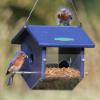This past weekend I made a pie. Not a big deal you'd think. I make pies from time to time. I actually made two. One was my signature
Chocolate Chess Pie, about which I have blogged on my historical food blog,
Peacock With Stuffing. I was making these pies to take them to the annual Eastern Star Christmas Dinner, (Eastern Star being the woman's side of the Mason's Lodge to which my husband belongs.) The other pie was a new one for me, a Chocolate Pecan Pie, which I decided I'd make with Sorghum, a lovely syrup made with cane sugar, rather than the corn syrup commonly used to make pecan pies.
Sorghum, being rather particularly a Kentucky food, seemed more appropriate to use than corn syrup. Besides, corn syrup is just, well, rather yucky. And I found this great company in Louisville,
Bourbon Barrel Foods, from which I could mail order this lovely stuff. A tin of it had arrived in good time, I had the
recipe from their website to work from, and I was all set.
Except, well, I am persnickety, and a pain in the ass in general. I badgered the poor dear intern who runs Bourbon Barrel Food's Facebook Page with questions about the recipe. What kind of chocolate? Melted? Chips? Bakers? (Horrors.) She politely and in a timely fashion replied that she used chocolate chips. I tossed that aside and decided to get Ghirardelli, in at least a 60% cacao, and wound up getting two bars, one 60% and one 72% and using some of each to get the one cup of chocolate called for in the recipe. If I'd had time I would have mail ordered some Callebaut Intense Dark, but I didn't, so oh well.
Then there was the question of timing on the cooking. The recipe is vague. For how long should it cook? And should I cover the pie crust? (I did, I have those lovely pie crust covering things from King Arthur Flour that do such a good job.) I wound up cooking it almost too long, and it wound up almost but not quite burned, and I'm not going to post the photo in this blog post because, well, it twernt pretty. And besides, I'm going to do a follow-up post. But it tasted splendid.
But the interesting part was at the party. As I brought my pies in, I fully expected my Chocolate Chess Pie to be the hit. It usually is. It's my signature pie, and as it is somewhat obscure (although I have recently been told it's very common in Louisville), I expected everyone to oooh and aaaah over it. Nope. Not a peep. It sat there, at least for a while (eventually it was eaten.) But once I told people the other pie was a Sorghum Chocolate Pecan Pie, that thing flew out the door of the kitchen. One guy actually took two pieces, put them on a plate, and didn't even eat them, just jealously guarded them all afternoon. I think he took them home.
But the part that you could have knocked me over with a feather about came later. One of the older ladies came up to me, introduced herself, and get this,
asked me for my recipe for my pie. I thought I was going to fall down. I was honest, said it was not my recipe, and told the several ladies who had gathered where I had gotten it from. But you have to understand. My husband and I moved to the extremely rural area in which we live here in Kentucky about ten years ago from Minnesota. Neither of us is originally from Minnesota, but that doesn't matter, we are known as "those people from Minnesota." And for me, that Yankee girl, to have the local matriarch of the Thompson clan (and clan they are!) ask me,
me! for my recipe, is a thing of wonder indeed.
Later, one of the other ladies asked me where I got my "sargum." I told her, BBF. She said, "Oh, you can get it at "X Local Grocery Store." Hmm. I had no idea. So after the dinner (it was still early afternoon) we stopped by and bought a jar. Oddly, it did not say Sorghum on the label, rather Molasses, but the man who owns the place (a local legend with whom I would never want to argue, as I am Not From Here), insisted it was the real deal.
I brought it home, and compared it to what was left in the bottom of the can from BBF. Not at all the same color. Hmm again. The next day I called the number on the jar of the "Molasses that was called Sorghum", and spoke to the man who made it. He was vague and unhelpful, and even said he didn't know what sort of cane he made his syrup from. Hmmm a third time. I found that suspicious. So I mail ordered some more Sorghum from a third source, and once it arrived noted it was dark, but not as dark as the "Molasses that was called Sorghum" but not as light as the lovely stuff from BBF.
So today I broke down and got a case from BBF. And am going to make a whole suite of pies, and do some taste testing and recipe tweaking, and when I do I'll post more pictures and an update. And I know some friends and foodies who'll be getting some real Kentucky Sorghum for Christmas this year. Because this stuff rocks, and I am obsessed. So much so that when I wake up in the wee hours of the morning (as I do from time to time) I find myself thinking about Sorghum. And that just ain't right. But it sure is sweet!
















